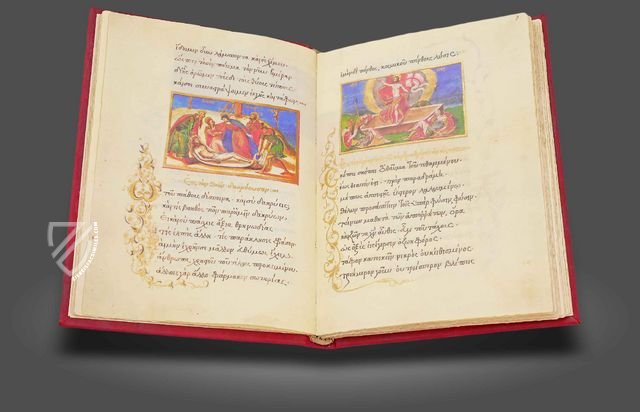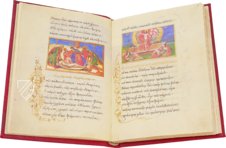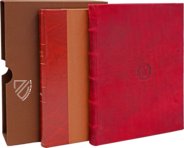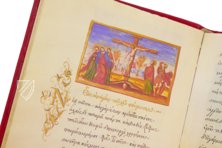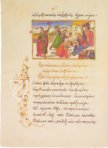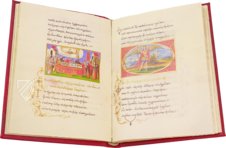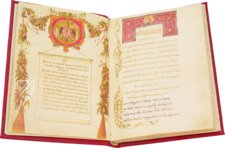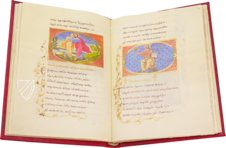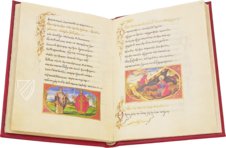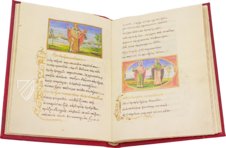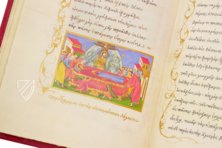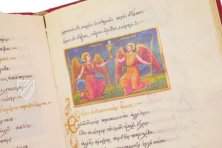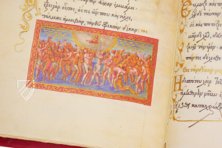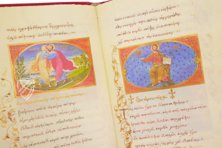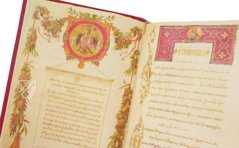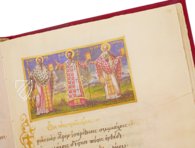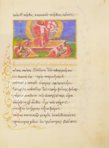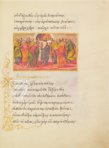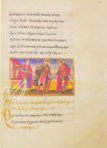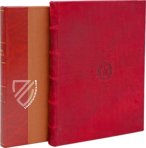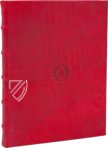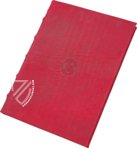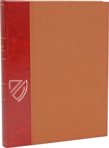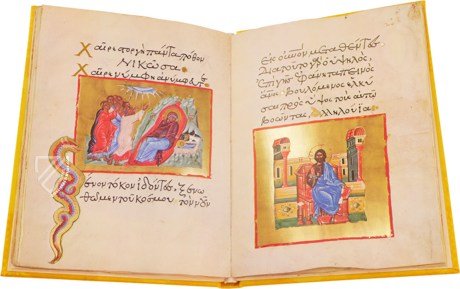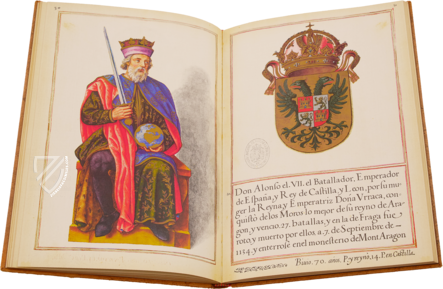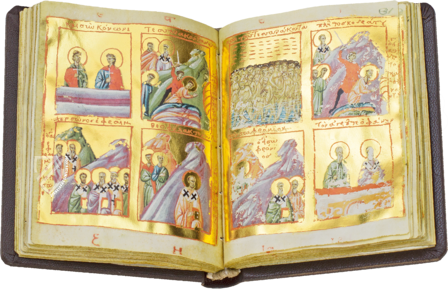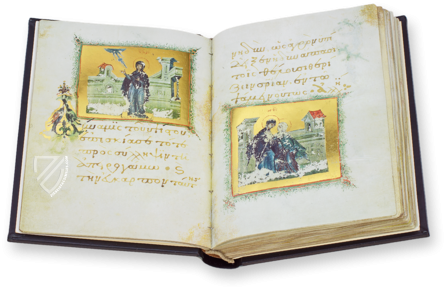Byzantine Epigrams and Icons of John of Euchaita
(1,000€ - 3,000€)
This valuable manuscript, which is housed today in the famous El Escorial library, collects 99 epigrams by one of the most important Byzantine scholars and poets: John Mauropus or John of Euchaita. This influential spiritual scholar in Constantinople composed the verse and short poems concerning church festivities, dirges, and various political or literary themes. The wonderfully furnished manuscript from the personal belongings of Philip II originates from the 16th century and was created by Nicolas de la Torre, the most favored miniaturist of the Spanish King. The gorgeous Greek text was illustrated with numerous splendid and high-quality miniatures and opulent ornaments. In this way the great art of 16th century Spanish illumination is combined with the most significant Byzantine text of the 11th century into a unique artistic synthesis.
Byzantine Epigrams and Icons of John of Euchaita
This valuable manuscript, which is housed today in the famous El Escorial library, collects 99 epigrams by one of the most important Byzantine scholars and poets: John Mauropus or John of Euchaita. This influential spiritual scholar in Constantinople composed the verse and short poems concerning church festivities, dirges, and various political or literary themes. The wonderfully furnished manuscript from the personal belongings of Philip II originates from the 16th century and was created by Nicolas de la Torre, the most favored miniaturist of the Spanish King. The gorgeous Greek text was illustrated with numerous splendid and high-quality miniatures and opulent ornaments. In this way the great art of 16th century Spanish illumination is combined with the most significant Byzantine text of the 11th century into a unique artistic synthesis.
A Jewel from an Important Library
Philip II (1527–1598), King of Spain and builder of El Escorial, was a prominent friend and patron of the arts. In his royal monastery of San Lorenzo de El Escorial, he assembled an outstanding library along with treasures from all areas of art. This collection of book treasures is famous up to this day. It comprises inter alia an important stock of Greek and Byzantine literature. A particularly valuable specimen from these holdings is the manuscript of the Byzantine Epigrams and Icons of John of Euchaita in a splendid manuscript from the 16th century, which came into the possession of Philip II in the year 1567.
A Master of the Byzantine Art of Poetry
John Mauropus or John of Euchaita was an important 11th century Byzantine scholar and cleric. He worked in Constantinople as a teacher at the University of Constantinople, where famous and influential people were his students. Additionally, John of Euchaita was a minister under Emperor Constantine IX (1042–1055) and was counted among a circle of intellectuals that the Emperor assembled around himself. He has achieved fame up to this day though his papers, epigrams, and letters. Following unknown circumstances, he was nevertheless banned from the imperial court and from Constantinople to Euchaita, a small city in the north of Asia Minor in modern Turkey, where he was active as the Metropolitan of the Orthodox Church.
Epigrams and Icons
The manuscript with epigrams and icons collects evidence of his influential writings from the 11th century. The literary texts of John of Euchaita stand in the tradition of the famous Marian hymn, Hymno Akathistos. The 99 epigrams of the manuscript in El Escorial concern themselves with various themes such as the progress of the 12 largest festivals of the Orthodox calendar, or dirges. Nonetheless, not only religious but also political, literary, or other subjects were described. The Greek text makes it possible to directly immerse oneself in the great art of the Byzantine poet.
Greek Text and Illustration in Opulent Splendor
The artist of the manuscript, the copy of the 11th century original, was Nicolas de la Torre, the favorite miniaturist of King Philip II. He furnished John of Euchaita’s text with gorgeous initials, which always reach beyond the margins and into the script. They are embellished with artful golden ornaments, these pass over the entire length of the pages as decorative bordures and offers the full splendor of the Renaissance to the eye of the beholder. Square-framed miniatures are always to be found in suitable places in the text. These gorgeous, exceedingly high-quality paintings stand out through their opulent colorfulness and their fine, gilded ornaments. The outstanding miniaturist clearly oriented himself stylistically on Byzantine painting, but allows clear influences from his time period, the Renaissance, to be recognized. The marvelous scenes, which vividly illustrate the 11th century Greek text, arose in this way and make the manuscript a true treasure of illumination and literature.
Codicology
- Alternative Titles
- Epigramas e Iconos Bizantinos de Juan de Eucaita
Exposición en verso de las fiestas de la Iglesia Griega
Byzantinische Epigramme und Ikonen von Johannes Mauropous, Bischof von Euchaita
Joannis metropolitae Euchaitorum in tabulas magnas festorum ad modum expositionis - Size / Format
- 136 pages / 32.0 × 23.5 cm
- Origin
- Spain
- Date
- 16th century
- Epochs
- Style
- Language
- Illustrations
- Over 30 miniatures illustrating the scenes
- Content
- 99 Epigrams for worship along the 12 feasts of the Orthodox Church year
- Patron
- Philip II, King of Spain (1527–1598)
- Artist / School
- Juan de Eucaita (Juan Mauropous, 11th century) (author)
Nicolás de la Torre (scribe and illuminator)
#1 Epigramas e Iconos Bizantinos de Juan de Eucaita
Language: Spanish
(1,000€ - 3,000€)
- Treatises / Secular Books
- Apocalypses / Beatus
- Astronomy / Astrology
- Bestiaries
- Bibles / Gospels
- Chronicles / History / Law
- Geography / Maps
- Saints' Lives
- Islam / Oriental
- Judaism / Hebrew
- Single Leaf Collections
- Leonardo da Vinci
- Literature / Poetry
- Liturgical Manuscripts
- Medicine / Botany / Alchemy
- Music
- Mythology / Prophecies
- Psalters
- Other Religious Books
- Games / Hunting
- Private Devotion Books
- Other Genres
- Afghanistan
- Armenia
- Austria
- Belgium
- Belize
- Bosnia and Herzegovina
- China
- Colombia
- Costa Rica
- Croatia
- Cyprus
- Czech Republic
- Denmark
- Egypt
- El Salvador
- Ethiopia
- France
- Germany
- Greece
- Guatemala
- Honduras
- Hungary
- India
- Iran
- Iraq
- Israel
- Italy
- Japan
- Jordan
- Kazakhstan
- Kyrgyzstan
- Lebanon
- Liechtenstein
- Luxembourg
- Mexico
- Morocco
- Netherlands
- Palestine
- Panama
- Peru
- Poland
- Portugal
- Romania
- Russia
- Serbia
- Spain
- Sri Lanka
- Sweden
- Switzerland
- Syria
- Tajikistan
- Turkey
- Turkmenistan
- Ukraine
- United Kingdom
- United States
- Uzbekistan
- Vatican City
- A. Oosthoek, van Holkema & Warendorf
- Aboca Museum
- Ajuntament de Valencia
- Akademie Verlag
- Akademische Druck- u. Verlagsanstalt (ADEVA)
- Aldo Ausilio Editore - Bottega d’Erasmo
- Alecto Historical Editions
- Alkuin Verlag
- Almqvist & Wiksell
- Amilcare Pizzi
- Andreas & Andreas Verlagsbuchhandlung
- Archa 90
- Archiv Verlag
- Archivi Edizioni
- Arnold Verlag
- ARS
- Ars Magna
- ArtCodex
- AyN Ediciones
- Azimuth Editions
- Badenia Verlag
- Bärenreiter-Verlag
- Belser Verlag
- Belser Verlag / WK Wertkontor
- Benziger Verlag
- Bernardinum Wydawnictwo
- BiblioGemma
- Biblioteca Apostolica Vaticana (Vaticanstadt, Vaticanstadt)
- Bibliotheca Palatina Faksimile Verlag
- Bibliotheca Rara
- Boydell & Brewer
- Bramante Edizioni
- Bredius Genootschap
- Brepols Publishers
- British Library
- C. Weckesser
- Caixa Catalunya
- Canesi
- CAPSA, Ars Scriptoria
- Caratzas Brothers, Publishers
- Carus Verlag
- Casamassima Libri
- Centrum Cartographie Verlag GmbH
- Chavane Verlag
- Christian Brandstätter Verlag
- Circulo Cientifico
- Club Bibliófilo Versol
- Club du Livre
- CM Editores
- Collegium Graphicum
- Collezione Apocrifa Da Vinci
- Comissão Nacional para as Comemorações dos Descobrimentos Portugueses
- Coron Verlag
- Corvina
- CTHS
- D. S. Brewer
- Damon
- De Agostini/UTET
- De Nederlandsche Boekhandel
- De Schutter
- Deuschle & Stemmle
- Deutscher Verlag für Kunstwissenschaft
- DIAMM
- Droz
- E. Schreiber Graphische Kunstanstalten
- Ediciones Boreal
- Ediciones Grial
- Ediclube
- Edições Inapa
- Edilan
- Editalia
- Edition Deuschle
- Edition Georg Popp
- Edition Leipzig
- Edition Libri Illustri
- Editiones Reales Sitios S. L.
- Éditions de l'Oiseau Lyre
- Editions Medicina Rara
- Editorial Casariego
- Editorial Mintzoa
- Editrice Antenore
- Editrice Velar
- Edizioni Edison
- Egeria, S.L.
- Eikon Editores
- Electa
- Emery Walker Limited
- Enciclopèdia Catalana
- Eos-Verlag
- Ephesus Publishing
- Ernst Battenberg
- Eugrammia Press
- Extraordinary Editions
- Fackelverlag
- Facsimila Art & Edition
- Facsimile Editions Ltd.
- Facsimilia Art & Edition Ebert KG
- Faksimile Verlag
- Feuermann Verlag
- Folger Shakespeare Library
- Franco Cosimo Panini Editore
- Friedrich Wittig Verlag
- Fundación Hullera Vasco-Leonesa
- G. Braziller
- Gabriele Mazzotta Editore
- Gebr. Mann Verlag
- Gesellschaft für graphische Industrie
- Getty Research Institute
- Giovanni Domenico de Rossi
- Giunti Editore
- Graffiti
- Grafica European Center of Fine Arts
- Guido Pressler
- Guillermo Blazquez
- Gustav Kiepenheuer
- H. N. Abrams
- Harrassowitz
- Harvard University Press
- Helikon
- Hendrickson Publishers
- Henning Oppermann
- Herder Verlag
- Hes & De Graaf Publishers
- Hoepli
- Holbein-Verlag
- Houghton Library
- Hugo Schmidt Verlag
- Idion Verlag
- Il Bulino, edizioni d'arte
- ILte
- Imago
- Insel Verlag
- Insel-Verlag Anton Kippenberger
- Instituto de Estudios Altoaragoneses
- Instituto Nacional de Antropología e Historia
- Introligatornia Budnik Jerzy
- Istituto dell'Enciclopedia Italiana - Treccani
- Istituto Ellenico di Studi Bizantini e Postbizantini
- Istituto Geografico De Agostini
- Istituto Poligrafico e Zecca dello Stato
- Italarte Art Establishments
- Jan Thorbecke Verlag
- Johnson Reprint Corporation
- Josef Stocker
- Josef Stocker-Schmid
- Jugoslavija
- Karl W. Hiersemann
- Kasper Straube
- Kaydeda Ediciones
- Kindler Verlag / Coron Verlag
- Kodansha International Ltd.
- Konrad Kölbl Verlag
- Kurt Wolff Verlag
- La Liberia dello Stato
- La Linea Editrice
- La Meta Editore
- Lambert Schneider
- Landeskreditbank Baden-Württemberg
- Leo S. Olschki
- Les Incunables
- Liber Artis
- Library of Congress
- Libreria Musicale Italiana
- Lichtdruck
- Lito Immagine Editore
- Lumen Artis
- Lund Humphries
- M. Moleiro Editor
- Maison des Sciences de l'homme et de la société de Poitiers
- Manuscriptum
- Martinus Nijhoff
- Maruzen-Yushodo Co. Ltd.
- MASA
- Massada Publishers
- McGraw-Hill
- Metropolitan Museum of Art
- Militos
- Millennium Liber
- Müller & Schindler
- Nahar - Stavit
- Nahar and Steimatzky
- National Library of Wales
- Neri Pozza
- Nova Charta
- Oceanum Verlag
- Odeon
- Orbis Mediaevalis
- Orbis Pictus
- Österreichische Staatsdruckerei
- Oxford University Press
- Pageant Books
- Parzellers Buchverlag
- Patrimonio Ediciones
- Pattloch Verlag
- PIAF
- Pieper Verlag
- Plon-Nourrit et cie
- Poligrafiche Bolis
- Presses Universitaires de Strasbourg
- Prestel Verlag
- Princeton University Press
- Prisma Verlag
- Priuli & Verlucca, editori
- Pro Sport Verlag
- Propyläen Verlag
- Pytheas Books
- Quaternio Verlag Luzern
- Reales Sitios
- Recht-Verlag
- Reichert Verlag
- Reichsdruckerei
- Reprint Verlag
- Riehn & Reusch
- Roberto Vattori Editore
- Rosenkilde and Bagger
- Roxburghe Club
- Salerno Editrice
- Saltellus Press
- Sandoz
- Sarajevo Svjetlost
- Schöck ArtPrint Kft.
- Schulsinger Brothers
- Scolar Press
- Scrinium
- Scripta Maneant
- Scriptorium
- Shazar
- Siloé, arte y bibliofilia
- SISMEL - Edizioni del Galluzzo
- Sociedad Mexicana de Antropología
- Société des Bibliophiles & Iconophiles de Belgique
- Soncin Publishing
- Sorli Ediciones
- Stainer and Bell
- Studer
- Styria Verlag
- Sumptibus Pragopress
- Szegedi Tudomànyegyetem
- Taberna Libraria
- Tarshish Books
- Taschen
- Tempus Libri
- Testimonio Compañía Editorial
- Thames and Hudson
- The Clear Vue Publishing Partnership Limited
- The Facsimile Codex
- The Folio Society
- The Marquess of Normanby
- The Richard III and Yorkist History Trust
- Tip.Le.Co
- TouchArt
- TREC Publishing House
- TRI Publishing Co.
- Trident Editore
- Tuliba Collection
- Typis Regiae Officinae Polygraphicae
- Union Verlag Berlin
- Universidad de Granada
- University of California Press
- University of Chicago Press
- Urs Graf
- Vallecchi
- Van Wijnen
- VCH, Acta Humaniora
- VDI Verlag
- VEB Deutscher Verlag für Musik
- Verlag Anton Pustet / Andreas Verlag
- Verlag Bibliophile Drucke Josef Stocker
- Verlag der Münchner Drucke
- Verlag für Regionalgeschichte
- Verlag Styria
- Vicent Garcia Editores
- W. Turnowski Ltd.
- W. Turnowsky
- Waanders Printers
- Wiener Mechitharisten-Congregation (Wien, Österreich)
- Wissenschaftliche Buchgesellschaft
- Wissenschaftliche Verlagsgesellschaft
- Wydawnictwo Dolnoslaskie
- Xuntanza Editorial
- Zakład Narodowy
- Zollikofer AG

